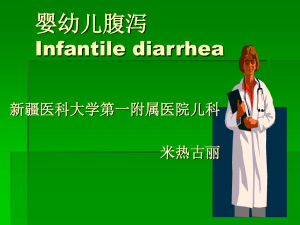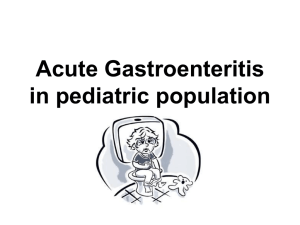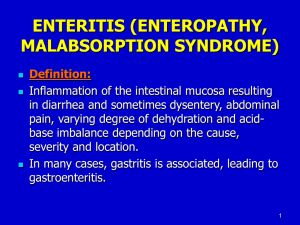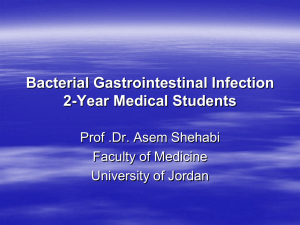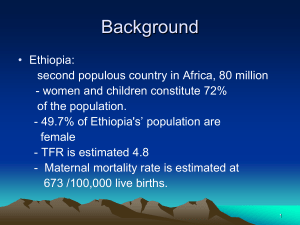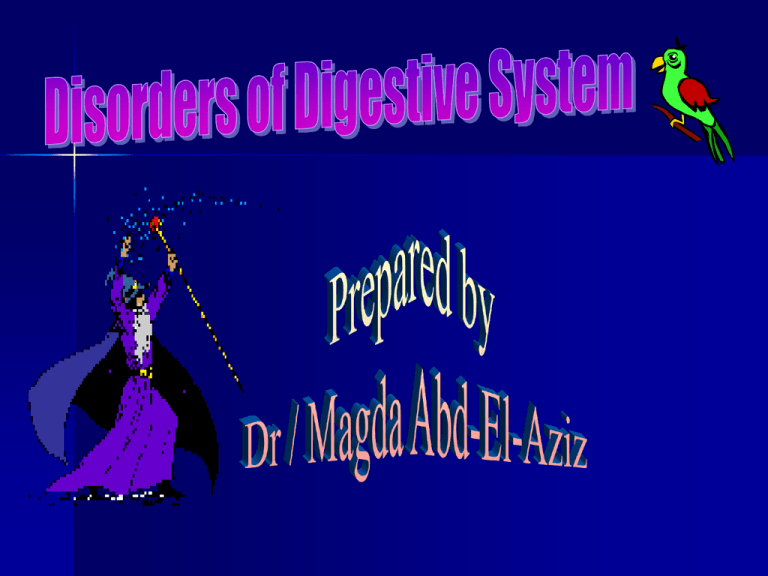
INTRODUCTION
Focuses on most common gastrointestinal
disorders such as foreign bodies in G .I .T
system,thrush stomatitis ,vomiting, colic,
constipation,diarrhea and
dehydration,major nursing diagnostic and
nursing intervention related to recognition
and management of the child.
By the end of this lecture the student
will be able to discuss Disorders of
Digestive System
Specific objectives:
By the end of this lecture the student nurse will be
able to::
Define the common gastrointestinal disorders
(ingestion of foreign bodies, stomatitis, vomiting,
colic, constipation, diarrhea and dehydration).
Mention the etiology and causative organisms of
these disorders.
Apply the nursing process to different
gastrointestinal disorders.
Provide health education to parents regarding the
management and prevention of common
gastrointestinal disorders.
Introduction.
Foreign body in G.I.T.
Stomatitis.
Vomiting.
Colic.
Constipation.
Diarrhea.
Dehydration.
Nursing intervention.
Prevention of diarrhea.
A- Foreign bodies in G.I.T
Etiology
The infant during the oral phase of development enjoys
putting objects into his mouth, as he sucks upon a small
object lie may swallow it. Objects may lodge at any part in
the stomach or pass through the intestinal tract or it may
perforate the intestine.
Assessment:
Observation for sign of perforation, which are: nausea
vomiting, blood in stools, tenderness of the abdomen,
evidence of pain.
Nursing diagnosis:
High risk for intestinal perforation related to
swallowing of foreign bodies.
Goal:
The infant/child will experience no signs of
perforation.
Intervention and treatment:
No specific nursing care other than close
observation of the child's stools and signs of
perforation. Stool must be placed in a fine mashed
sieve and water run with force upon it until the
fecal matter disintegrates and object if present is
clearly seen.
Outcome criteria:
The infant/child will experience normal bowel
movement.
B- Stomatitis
Definition:
Inflammation of the mucous membrane of
the mouth. It may be due to local lesion in
the mouth or a feature of a systemic disease
e.g. measles.
Causes of stomatitis:
Infection:
Viruses: measles, primary herpes simplex, coxsackie A.
Bacteria: streptococcus, diphtheria.
Fungus: monilia coral thrush.
Eruption stomatitis: associated with eruption of teeth.
Traumatic: cheek biters.
Local reactions: due to sensitivity to contact substances from
toys and foods.
Immunological impairment: in leukemias.
Drugs and poisons: phenytoin, salicylates,
corrosives.
Types of Stomatitis:
Catarrhal stomatitis.
Herpetic stomatitis.
Thrush stomatitis.
Thrush stomatitis:
Definition
It is a "fungus infection" of the skin and
mucous membrane of the mouth characterized
by white patches, resembling milk curds.
Etiology
Candida albicans infection is due to inadequate
sterilization of teats and bottles or from mother's
breast of the attendant's hand. Newborns are
infected during passage in birth canal.
Assessment:
Mouth contains white patches, which
resembles milk curds (it is difficult to
remove and if removed bleeding occurs).
Also there discomfort during feeding.
Nursing diagnosis
Altered oral mucous membrane related to
mouth infection.
Goal
Prevent and reduce the effects of oral
ulceration.
Nursing management
– Absolute cleanliness of all articles which enter
infants mouth-such as mothers nipple, rubber
nipple, pacifiers, teats, or his toys.
– Applicators used must be sterile.
– Infants must have their own feeding equipment
to prevent spread of infection.
– Medicine dropper may be used, if nipple irritates
the child.
– Give infant some sterile water after each feeding
to wash the mouth.
Expected outcome:
– Mouth membrane remains intact.
– Ulcers show evidence of healing.
Nursing diagnosis
Altered nutrition less than body requirements
related to loss of appetite. Also discomfort and
interference with feeding.
Goal:
Appetite stimulation.
Nursing management:
Encourage parents to relax pressure placed on
eating.
Allow infant any tolerated food; plan to
improve quality of food selection when
appetite increases.
Take advantage of any hungry period,
serve
small snacks.
Allow child to be involved in food
preparation selection.
Outcome criteria
The nutritional intake is adequate.
Medical treatment:
Treatment should be continued for one week after
recovery prevent recurrence.
Cleanliness and sterilization of the feeding bottles and
teats.
The infant's mouth is gently painted three times daily with
1% aqueous solution of gentian violet.
This may be combined with nystatine, 100.000 units by
month, 3 – 4 times daily.
Mother's nipple and areola painted with nystatine
ointment between meals.
Prognosis:
Generally very good, recovery occurs after (3 – 5) days.
C– Vomiting:
Complete or partial emptying of the
stomach especially when it occurs
sometimes after feeding i.e. bringing up
an appreciable amount of the swallowed
food.
Vomiting results from a coordinated
sequence of abdominal muscle
contractions and reverse esophageal
peristalsis. It is usually associated with
nausea except when projectile.
Vomiting is classified as follows:
Mechanical: secondary at an obstructive lesion.
Reflexive: due to gastrointestinal tract stimuli
(e.g. infection, allergy).
Central:
Central nervous system involvement (e.g.
neoplasms, meningitis).
Caused by other than primary central nervous
system involvement (e.g., abnormal metabolites,
sepsis, psychogenic vomiting).
Regurgitations:
Means to express "spill out" of "spill over"
a small amount of formula. a during or small
amount of swallowed food Also spitting up from
stomach shortly after eating. Or non forceful
expulsion of food and secretions from esophagus
or stomach through the mouth.
Differences between regurgitation and
vomiting:
Regurgitation is not accompanied by
nausea.
No forceful contraction of abdominal
muscle.
Occurs in early weeks of life.
A short time after feed babies
regurgitate small amounts (1-2
mouthfuls) of milk.
Weight gain is normal.
Doesn't need any treatment.
Rumination:
Means voluntary or habitual
regurgitation of formula into the mouth
after it has been swallowed i.e. returning
of food from stomach and chewing it
again . Vomiting is one of the most
common symptoms in infancy and may be
associated with a wide variety of
disturbances.
Causes of vomiting:
Causes of vomiting are classified according to different periods:
1- In newborn:
Physiological vomiting at or soon after birth as a normal process by
which swallowed blood and amniotic fluid are removed. It may occur
once or twice.
Congenital esophegeal obstruction, which is manifested by
regurgitation, chocking and perhaps cyanosis with first feed.
Intestinal obstruction gives symptom usually in the first 24 hours after
birth.
Imperforated anus gives symptoms that begin on the first 24-36 hours
of life with abdominal distention,, vomiting and meconium is passed.
Cerebral birth injuries due to stimulation of vomiting center in the
.
brain
2. In infancy:
Improper feeding habit
Over feeding or underfeeding.
Error in feeding technique.
Failure to eructate.
Too small teat.
Excessive handling after feeding.
Placing baby on left side after feeding.
Too tight clothing especially around the
abdomen.
Infections such as otitis media, tonsillitis,
pyelitis and pneumonia.
Acute diarrheal diseases due to bacterial
or viral infection in the intestinal tract.
Intestinal obstruction e.g. pyloric stenosis
or intussusception.
Cerebral causes as hydro-cephalus
3- In older children :
Dietary causes e.g. ingestion of unripe fruits or contaminated
food.
Acute infections such as streptococcal pharyngitis, diphtheria,
reflex vomiting in pertussis or intestinal infection as food
poisoning.
Drugs as digitalis, sulphonamides, broad-spectrum antibiotics.
lntracranial hemorrhage and brain tumors.
Organic nervous diseases e.g. meningitis, encephalitis.
.Metabolic disturbances as in diabetic acidosis.
Psychogenic vomiting as by forcing a child with poor appetite
to eat more than he wants.
Acute peritonitis due to development of paralytic ileus.
Assessment:
Failure to gain weight.
Feible, weak child with free perspiration.
Sometimes feeling of nausea.
Stomach pain.
Dehydration.
Alkalosis due to failure to retain food inside the
body.
Nursing diagnosis:
Fluid volume deficit related to nausea and
vomiting.
Goal:
To promote hydration.
Nursing intervention:
Correct the cause of vomiting.
Discontinue fluids and foods for older children by mouth for
12-24 hours permitting only crushed ice to alleviate dryness
of the mouth and resort to parental fluid.
In milder cases sips of cold drinks or glucose water.
Correct dehydration by parental fluid.
Mummy restraints to protect the IV and child as needed.
Mouth care after vomiting to prevent aspiration of vomitus.
Close observation if infant tends to vomit, whether he
tolerates food or not, or if he vomits immediately after
feeding (congenital abnormalities).
Nursing care should be planned to
eliminate unnecessary movement after
feeding.
Bubbling is very important.
Place child on right side and elevate
head of the bed after feeding.
Change soiled clothes and linen to
prevent skin irritation.
weight infants daily.
Charting amount, color, nature, odor,
consistency, and time in relation to
feeding.
Expected outcome:
Child shows signs of adequate hydration.
Nursing diagnosis:
Altered comfort related to acute pain in the
stomach.
Goal:
Relieve pain.
Intervention:
Refer to lecture of congenital anomalies.
Expected outcome:
Child rest quietly, shows no evidence of
discomfort, verbalizes no complaints of
discomfort.
D- Colic :
Definition:
Paroxysmal intestinal cramps occurring
due to accumulation of excessive gases
and cause discomfort and pain. It is most
common during the first 3 or 4 months of
life.
Etiology:
The causative factors are not known, but
it might be due to:
Excessive swallowing of air.
Too much excitement.
Excessive intake of carbohydrate leads to
gas formation.
Over rapid feeding.
Diseases of GIT e.g. gastroenteritis,
constipation .
Hernias: diaphragmatic, inguinal, or
umbilical.
Parasites.
Allergy to certain foods.
Hunger .
Intestinal obstruction e.g. pyloric
stenosis .
Emotional stress or tension between
parent and child.
Assessment :
Sudden attack of abdominal pain.
Cry in loud voice more or less continuous.
Distended and tense abdomen.
Congestion of face may be cyanotic in
severe cases.
Legs are drawn up on the abdomen.
Feet are often cold.
Arms are flexed and drawn to the body.
Neck may be flexed.
Infant may pass flatus or feces.
Nursing diagnosis :
Altered comfort related to colic.
Goal :
To relive pain.
Nursing intervention :
Bubble infant frequently and gently; use
upright position to help eructation.
Give infant hot watery fluids (as caraway) to
help expulsion of gases or use hot water
bottle.
Turn the infant on abdomen to help
expulsion of gases.
Loving care to relief his tension (hug
him).
Teach mother the details of good feeding
techniques.
Doctor may order small warm enema or
change formula.
Doctor may order drugs as atropine to
reduce intestinal movement.
Expected outcome :
Infant/child is resting and shows no
evidence of discomfort.
Constipation :
Definition :
Difficulty or insufficient passage of hard
stools at infrequent intervals.
Causes :
Underfeeding with insufficient intake of milk or
fluid.
Intestinal obstruction .
Pyloric stenosis .
Congenital Megacolon.
Infant receiving cow's milk.
Starvation.
Assessment:
Colic and passage of gases.
Passage of infrequent hard dry stools, which
occasionally fissures the rectum while being
expelled.
Distension of the rectum and colon.
Anxiety.
Nursing diagnosis:
Altered comfort related to acute colic.
Goal :
Infant/child will feel comfort.
Nursing intervention:
Increase fluid intake.
Laxative fluids e.g. orange juice relives mild
constipation.
Small soapy enema may be given.
Milk of magnesia may be used as a temporary
measure.
Establish or maintain regular bowel action by
nature means rather than using purgatives.
Psychological support to express his fear and his
own emotional reactions.
Expected outcome:
Infant/child will show no evidence of discomfort
and passes stool according to his habit.
Diarrhea Disorders
Definition:
It is defined as "An increase in the
fluidity, volume and number of
stools relative to the usual habits
of each individual".
Morbidity and Mortality in
Egypt:
Morbidity:
Diarrhea is a leading cause of illness among children in
developing countries. In Egypt a child under five years
suffers an average three bouts of acute diarrhea yearly;
that is to say 10 millions children suffer 30 millions
episodes of diarrhea every year.
Mortality:
Diarrhea accounts for 25 - 30% of deaths among children
under five years. It is estimated that 15000 Egyptian
infants and preschool children die yearly from diarrhea
(about 42 deaths every day), 80% of them being in the
first two years of life.
Factors promoting the transmission
of enteric pathogens:
Failure to breast – feed exclusively for the
1st 4 – 6 months.
Using infant feeding bottles (easily
contaminated).
Inappropriate storing of cooked food.
Using drinking water contaminated with
fecal bacteria.
Failing to dispose of feces hygienically
Failing to wash hands after defection.
Host factors: young age (highest incidence in
the age group 6 – 12 months).
Malnutrition.
Measles in the previous 4 weeks.
Immunodeficiency.
Season:
Bacterial diarrheas are more frequent in summer.
Rotavirus is more frequent in winter but occur
throughout year.
Types of diarrhea :
Acute Watery Diarrhea: (80% of cases)
This refers to diarrhea that begins suddenly; it persists for 3 4 days then gradually improves over another 4 - 5 days. It is
usually self-limited (lasts less than 14 days) and involves the
passage of frequent loose or watery stool without
visible blood.
Dysentery: (5 – 10% of cases)
This is diarrhea with visible fresh blood in the stools. Its
sequelae include anorexia and damage to the intestinal
mucosa.
Persistent Diarrhea: (10% of cases)
Post infectious diarrhea that begins actually and lasts at least
14) days. Persistent diarrhea is not chronic diarrhea which
is recurrent or long- lasting due to non-infectious causes.
(e.g. metabolic disorders).
Dangers of diarrhea :
Dehydration, which might lead to death if not properly,
treated.
Malnutrition: diarrhea is worse in persons with malnutrition
and can make it worst because:
Nutrition is lost from the body in diarrhea.
The patient may not be hungry (due to diminished
absorption).
Mothers may not feed their children during the episode or
even for some days after the diarrhea improves.
N.B. The life span of intestinal mucosal cells is 3-5 days. New
normal cells will replace the destroyed cells damaged by
toxins, within this period. This is why diarrhea is usually a
self-limited disease of 3-5 days duration.
Incidence of diarrhea :
The peak incidence of diarrhea is between
6 months to 2 years. This is due to:
Declining level of maternal antibodies.
Exposure to enteric pathogens through contaminated
weaning food.
The pleasure of picking -up contaminated objects and putting
them in the mouth while crawling.
Seriousness of diarrheal disorders during infancy :
Their higher needs for water exchange to meet their high
metabolism.
Greater susceptibility of infants to infection .
Lower power of their kidneys to concentrate urine, which
results in relative polyuria.
Their smaller metabolic reserves of water and electrolytes.
Therefore, with limited intake and /or extra loss of fluid
during diarrhea, acute dehydration usually occurs
Causes of diarrhea:
1- Enteropahtogenic: (infectious diarrhea)
Viruses (rotavirus) (15 – 25% of cases).
Bacteria (E.Coli 10 – 20% of cases), (shigell 5 –
15% of cases).
Protozoa (cryptosporidium 5-15% of cases).
Other less common pathogens include (Giardia doudenaris, Entamoeba histoloticày
andsalomnella).
2- Dietary :
A-Formula feeding problems:
Contaminated feeding bottles.
Overfeeding.
Over concentrated formula.
Excess sugar or fat in formula.
B-Weaning food problems:
Introduction of food, which is not suitable for
the age.
Unripe fruits.
Introduction of new food.
Improperly cooked diet.
Malnutrition .
3- Some parenteral infections:
Pneumonia and otitis media may be
accompanied by diarrhea. It may actually be due
to an associated intestinal infection.
Communicable diseases (e.g. measles) diarrhea
occurs due to immunological impairment.
4- Miscellaneous:
Emotional tension & Irritable colon.
Heavy metal poison (arsenic, lead,
mercury).
Antibiotic
5- Malabsorption:
Cystic fibrosis, ciliac disease.
N.B.
Teething
is not a cause of
diarrhea. Diarrhea that
occurs during teething is
usually caused by an
intestinal infection and
should be treated properly.
Dehydration
Definition
It is one of the consequences of watery
diarrhea. It is caused by the loss of water and
electrolytes in liquid or loose stools and vomitus.
Fever can make it worse as it causes additional
loss of water. Dehydration can lead to
hypovolemia, cardiovascular collapse, and death if
not treated promptly.
The signs of dehydration are the result of 2
important factors:
Type of dehydration: Isotonic, hyperonic,
hypotonic.
Degree: Mild, moderate or sever.
Types of dehydration:
1- Isotonic (isonatremic) dehydration: This is the most
common result of acute watery cliarrhea (more than
75% of cases). Deficits of water and sodium are
balanced .
2- Hypertonic (hypernatremic) dehydration the net loss
of water is greater than that of sodium . The
condition is more common in young infants who can't
verbally ask for water . It results from the intake of large
amounts of hpertonic fluids ( high content of sodium or
sugar ) during diarrhea.
3- Hypotonic (hypontremic) dehydration: it is less
common and the net loss of sodim is greater than
that of water. This result from the intake of large
amounts of water or hypnotic fluids during diarrhea.
Therapy of dehydration :
Oral rehudration:
The rehydrauon therapy in the form of ORS is
considered an effective treatment of
dehydration, It is a mixture of water, glucose,
and electrolytes and is used to correct or
prevent dehydration. Glucose is added (2%) to
promote sodium absorption. Increasing the
concentration of glucose by 2% increase the
osmolarity of the solution and may cause
osmotic diarrhea.
Composition of ORS :
Components g/1
Amount G/L
Sodium chloride.
3.5 G/L
Trisodium citrate.
2.9 G/L
potassium chloride
1.5 G/L
Glucose
20.0 G/L
N.B. The use of citrate increases the shelf life of
ORS and therefore lowers its cost. Tape water(200
ml) is used to dissolve the mixture and needs no
boiling. It is given by cup and spoon, but :
It can be given by nasogastric tube in the
following conditions :
When the patient is unable to drink but not in
shock, or has severe dehydration or paralytic ileus.
When the patient has severe repeated vomiting, or
if dehydration is not improving when ORS is given
slowly by cup and spoon.
Nursing management of
diarrhea
Nursing Assessment:
It includes taking the patient's history,
measuring weight and temperature and
Assessing the degree of dehydration.
1- History:
Personal characteristics (age and sex) and
socioeconomic background (home environment,
income, education, occupation, beliefs .... etc).
Duration of the episode.
Frequency and consistency of stool.
Presence or absence of mucus, pus or blood in
stool.
Patient's ability to drink and or presence of thirst.
Presence of vomiting, fever or other problems
(cough, otitis media).
Last time urine passed.
Feeding practices before and during illness.
Treatment during this episode (ORS, drugs).
Vaccination taken especially measles vaccine.
2- Assessment of the degree of dehydration:
Assessment of the degree of dehydration is
based on 4 signs which are the most important
to be detected:
Assessment of the degree of dehydration.
Sings
G-General
condition
E- Eyes
M- Thirst
S-Skin pinch
Decide
Select treatment
plan
A
No signs of
dehydration
loss < 5% of
body weight
B
Some dehydration
loss 5 – 10% of
body weight
C
Severe
dehydration
loss > 10% of
body weight
Well and alert
Restlessness and
irritable
Lethargic, floppy
unconscious
Normal
Sunken
Very sunken and dry
Drinks normally
Thirsty, drinks eagerly Drinks poorly or
unable to drink.
Goes back quickly
Goes back slowly
Patient has no sings
of dehydration
(mild)
If 2 or more signs are If 2 or more signs are
present, there is
present there is
moderate
severe
dehydration.
dehydration.
Plan A
Plan B
Goes back very
slowly (>2
seconds).
Plan C
Other signs that are used in the assessment of dehydration
are:
Anterior fontanel: normal, depressed or severely depressed.
Mucous membrane of the mouth and tongue: moist, dry or
very dry.
Tears: present in mild dehydration, absent in severe
dehydration.
Pulse (radial) as dehydration increase, pulse becomes more
rapid. In severe dehydration pulse becomes weak.
Extremities: in severe dehydration, skin becomes cool and
moist and the nail bed may be cyanosed.
Breathing : rapid deep breathing is a sign of acidosis.
Weighing is essential as it helps to estimate the amount of
fluid required, for an initial rehydration . Patient should
be weighted to the nearest 50 – 100 grams at the
beginning of the assessment and recorded. Towards
the end of rehydration , the child should have gained
weight.
Nursing
diagnosis:
Bowel elimination is altered related to
diarrhea.
Fluid and electrolyte balanced is altered
related to diarrhea.
Altered nutrition less than body requirement
related to loss of appetite.
High risk for infection related to body
resistance.
Altered parenthood related to knowledge
deficit about child care.
Nursing intervention:
The aim of nursing intervention is:
To hydrate the infant.
To feed the infant.
To deal with associated problems.
Treatment
Where
Plan A
At home
Plan B
In OP rehydration
center
Plan C
In hospital
1- Fluid therapy
Give more fluid Gives ORS
than usual
Give IV fluids
What type
Home made
fluids (rice,
water, tea
without sugar,
soup, yogurt).
Pansol .Ringer's
lactate. Normal
saline.
How much
How given
-Give
after
each loose
stool for child
<2 years : 50
– 100ml
-For child > 2
years: 100 –
200 ml.
Goes back slowly
-100
-Slowly
Slowly (1 spoon
1-2 min) by cup
and spoon, cup
alone,
I.V.
(1
spoon 1-2 min)
-By cup and
spoon, cup
ml/kg of body
wt. given in 3 – 6
hrs.
-1st 30 ml/kg given i
1/ to 1 hr.
2
-Next 70 ml/kg given
in 2.5 – 5hrs, longer
time is used for infa
< 1 year. (NB*)
Further assessment
A) Advice the mother to
bring the child to a
health facility if :
-Frequent large stools.
-Repeated vomiting
-Increased thirst
-No improvement after days
-Bloody stools .
-Fever.
B) Reassess the patient's
condition.
-If no signs of dehydration shift
to plan A.
-Some dehydration shift to plan
B
-Severe dehydration shift to
plan C.
Guidance during intervention :
Mothers should be taught how to give ORS (one
teaspoonful every 1-2 minutes and the child
should be in a semi-sitting position).
Give ORS as much as the desires.
If vomiting occurs, wait 10 minutes. then continue
giving ORS solution but more slowly (one
teaspoonful every 2-3 minutes).
Watch for puffy eyes as a sign of over hydration.
If this occurs, stop ORS solution and give breast
feeding and plain water. When puffiness is gone,
the child is considered fully dehydrated . Further
treatment should follow treatment plan A.
Feeding during and after the episode:
– During diarrhea give the child as much food
as he wants.
– Offer food every 3-4 hours.
– Small frequent feeding are better tolerated
than less frequent and large feedings.
– Children will anorexia have to be gently
encouraged to eat.
– After stoppage diarrhea, give one extra meal
per day for 2 weeks in normal child and
longer period in malnourished one .
Advantage of continued feeding during
diarrhea.(important point)
Preserves body weight and sustains growth, thus
maintaining strength and health avoiding lowered
resistance.
The contact of foodstuffs with the gut mucosa
protects its absorptive capacity and stimulates the
production of digestive enzymes.
Easily digestible foods may enhance intestinal
salt and water absorption by providing organic
molecules, which facilities their absorption.
Studies have shown that continued feeding
actually hastens recovery from a diarrheal
episode.
Assessment of the progress of
rehydration
The patient's progress should be
assessed at least every hour .
The signs of a satisfactory response
are:
Return of a strong radial pulse.
Improved consciousness level.
Ability to drink.
Much improved skin turgor.
Passage of urine
Drugs therapy in diarrhea :
1- Antibiotic are ineffective and may lead to(
prolonged diarhea –cause malabsorptionhave side effect – prolong the duration of
infection – their abuse will increase the
resistance of organism).
2 - Anti - diarrheal drugs.
3 - Anti -motility drugs.
4 - Anti – emetics.
Prevention of diarrhea:
1- Promotion of breast-feeding
2- Improved weaning practices
3- Proper use of water for hygiene and
drinking:
4- Personal hygiene
5- Use of latrines
6- Safe disposal of stools of young children
7- Measles vaccination
Thanks….
But it’s not the end !!!

